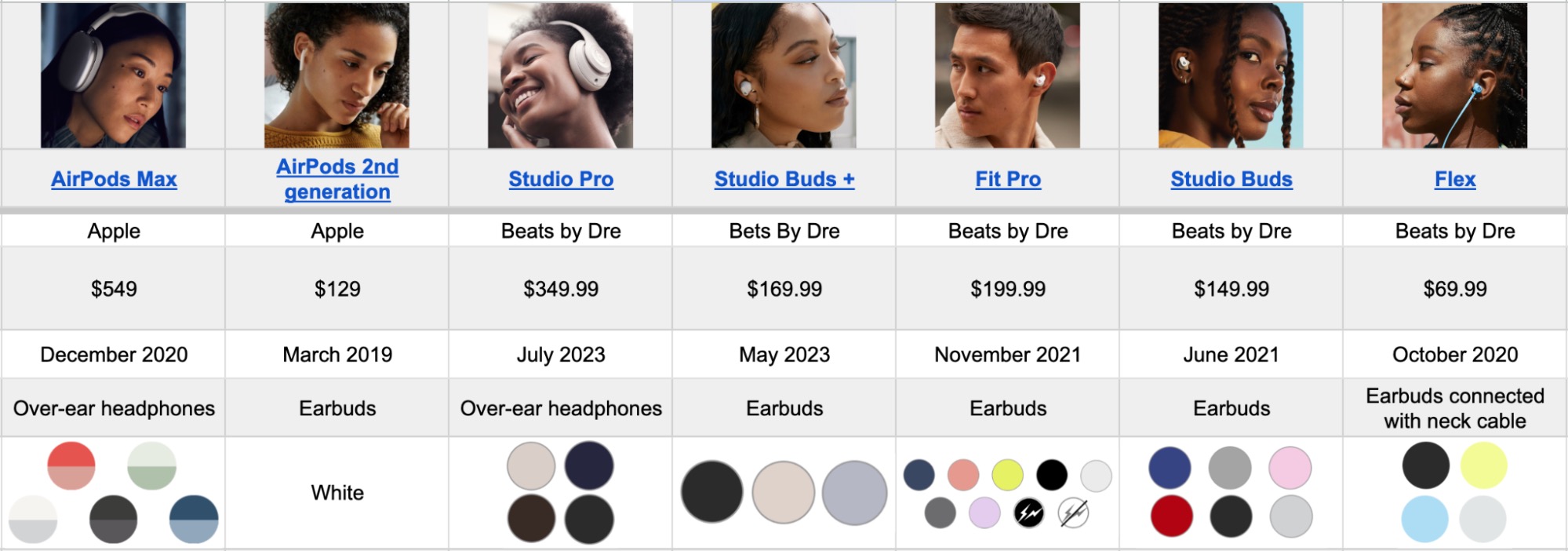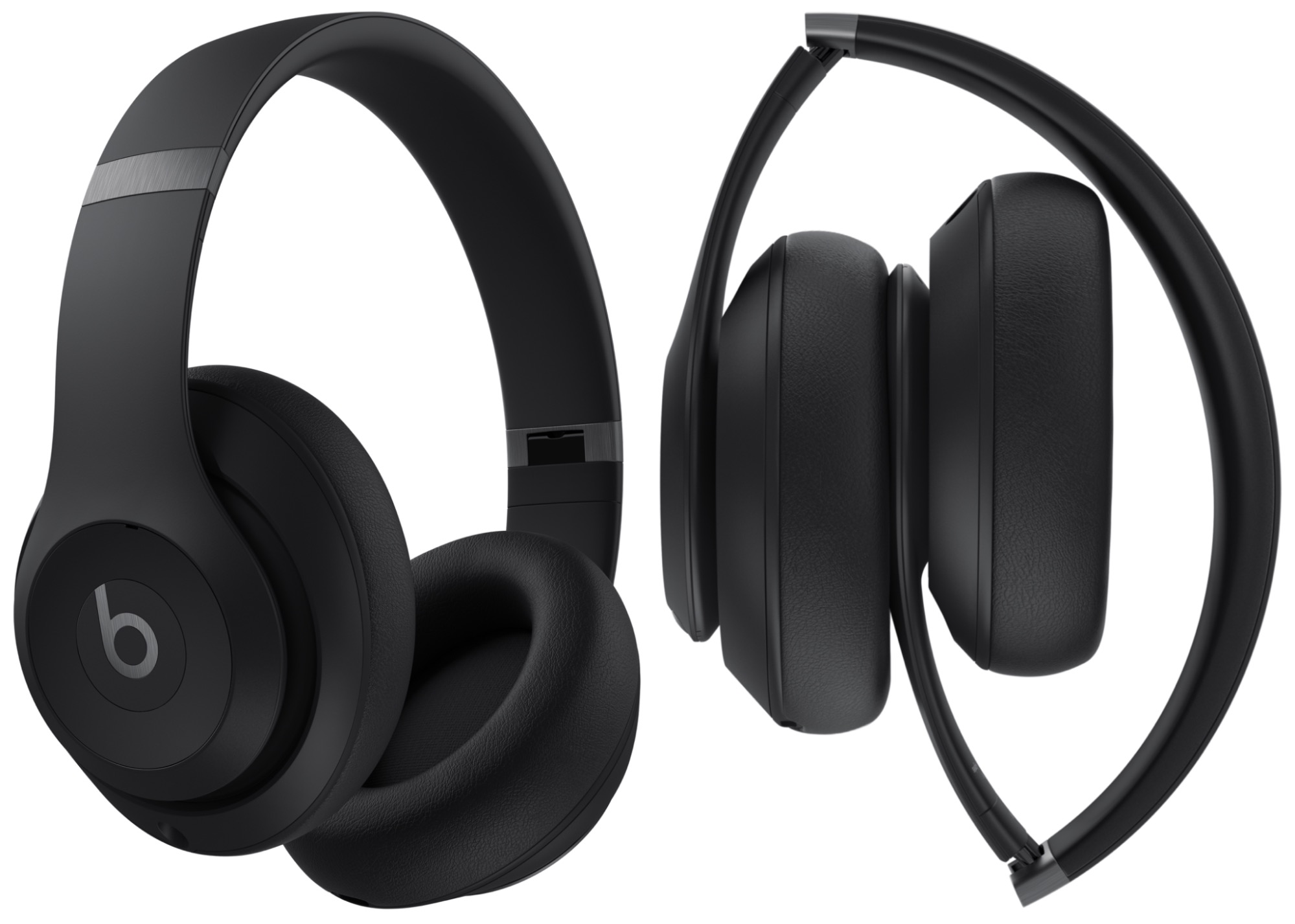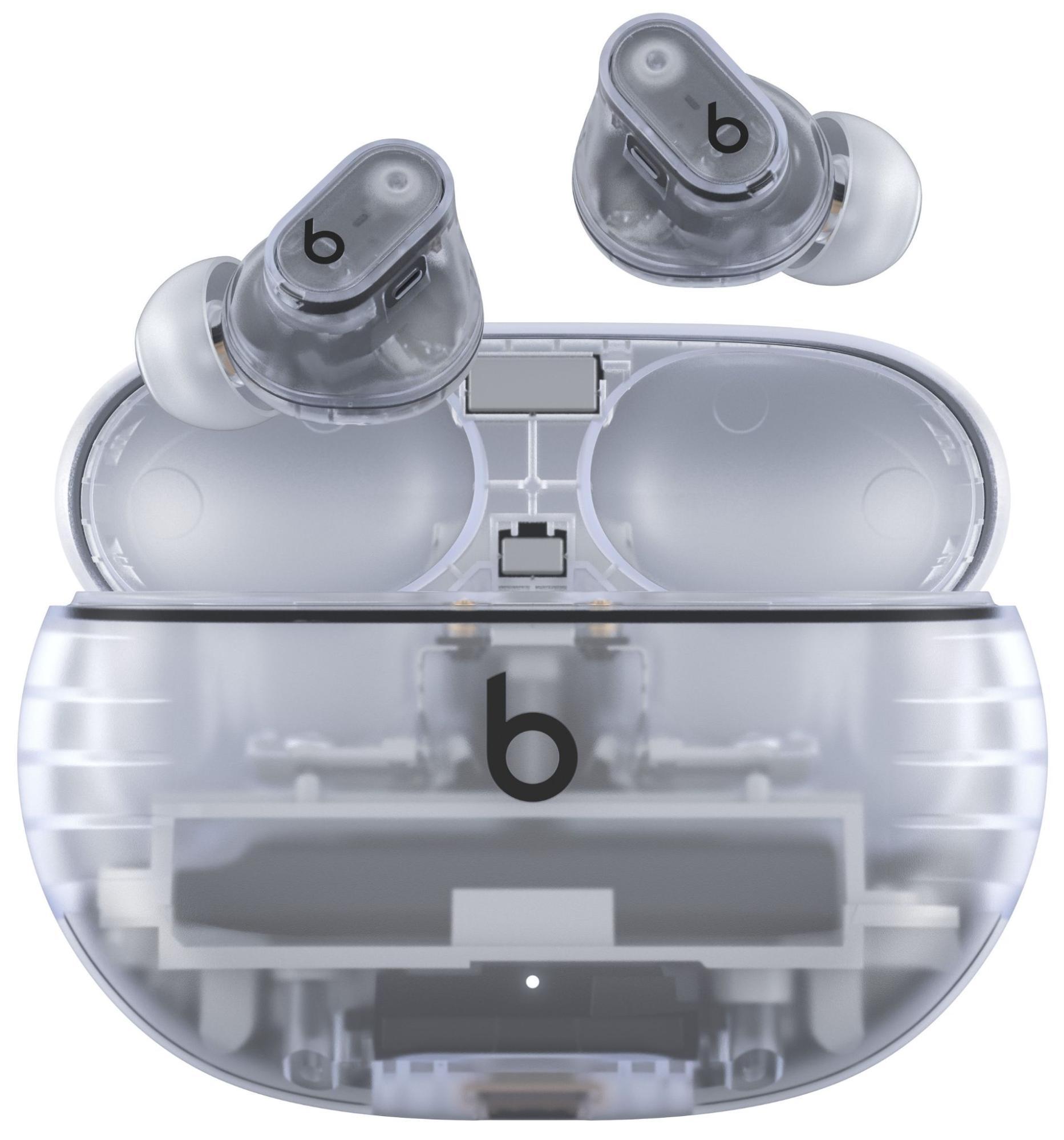The Beats Go On: Apple Subsidiary Releases Studio Pro Headphones, Studio Buds+ Earbuds
Most who shop for Apple wireless earbuds or headphones will stick to products with “AirPods” in their names. But the company’s wireless-audio line is more extensive—making your research more complicated, but potentially more rewarding—if you factor in the products from Apple’s Beats by Dre subsidiary (see “The Ultimate Guide to Choosing Apple/Beats Audio Gear,” 19 July 2021).
There are a couple of recent developments on that front to report.
In May, Beats released the $169.99 Studio Buds+, an incremental upgrade to the $149.99 Studio Buds that came out in June 2021. The Studio Buds+ are tempting because they cost the same as the third-generation AirPods but have advanced features found in the $249 second-generation AirPods Pro (see “Second-Generation AirPods Pro Add H2 Chip, Touch Control, Enhanced Case,” 7 September 2022). Aesthetic changes, in the form of a translucent color option, might also boost sales.
The meatier Beats news is an upgrade to its flagship Studio³ Wireless headphones from October 2017. The new Studio Pro headphones, released last month, resemble other Beats headphones but break new ground with features like wired playback over USB-C. At $349.99, they’re a bargain compared to Apple’s $549 AirPods Max (see “Apple’s AirPods Max Headphones Are Pricey but Good,” 15 March 2021).
This article walks you through the key features of the Studio Pro and Studio Buds+, while putting them into context for those open to looking beyond AirPods.
I won’t venture into the weeds of every available spec. Instead, check out my monster spreadsheet comparing Beats and AirPods in a feature-grid format, updated for the latest products.
Together, the Studio Pro and Studio Buds+ make a decent case for going Beats instead of AirPods—at least for some people.
Studio Pro Over-the-Ear Headphones
I have never used the Studio³ Wireless headphones, but I am intimately familiar with the Beats Solo Pro headphones (released in 2019 and retired in 2021), and it’s notable how little the Beats design language has evolved in the Studio Pro. Much like Beats devices dating back to the late aughts, the new headphones offer a collapsible, slightly creaky metal and plastic construction with a signature lowercase “b” on both earcups. If you hunger for cutting-edge industrial design in headphones, the AirPods Max will be more your speed.
Beats advertises its products as tightly integrated with Apple tech (as well as Android, for those who don’t live in the Appleverse and aren’t good AirPods candidates). The Studio Pro headphones are no exception.
Supported capabilities include one-touch pairing, iCloud sync, hands-free Siri, and Find My support. Spatial Audio with dynamic head tracking is on board. So is active noise cancellation (which electronically dampens exterior sounds to focus on music or podcast playback) and transparency mode (which lets in exterior audio when being aware of your surroundings is a priority).
The ANC and transparency work great but are not revolutionary. I keep waiting for ANC to improve to where it can blot out traffic and airplane-cabin noise, but that looks to be a long way off. And I will keep insisting that the humble $69.99 Beats Flex buds with passive noise cancellation, thanks to silicone ear tips that fit deeply into the ear canal, are the most effective way to block external audio.
The Studio Pro headphones notably lack some familiar Apple features, like audio sharing, automatic ear detection, and automatic device switching (that final feature does appear on Android, Beats unhelpfully tells me). The headphones use a special Beats chip—cryptically called “proprietary (2nd gen)”—instead of Apple’s H2 or H1, which would account for Apple-specific feature omissions while enhancing Android compatibility.
The Studio Pro headphones break some new ground. They’re the only ones in Apple’s portfolio to support wired playback via an included USB-C cable. This is in addition to regular wired playback using a bundled 3.5mm cable, which is an AirPods Max feature (but with no such cable included in that product’s box).
Active noise cancellation and transparency mode stop working if you plug in via USB-C, for unclear reasons, but you get other audio features. Lossless and high-res audio are supported over the wired hookup, which is great news for users of Apple Music, Tidal, and other services with lossless libraries.
Users can toggle among three “profiles” by double-pressing a button on the right earcup: Signature for tonally balanced music playback, Entertainment for gaming and movies, and Conversation for flatter audio suitable for podcasts and phone conversations. As a podcast enthusiast and NPR addict, I prefer Conversation mode.
These Studio Pro features result in aesthetically humdrum headphones that offer decent new functionality without the AirPods Max’s stratospheric price tag.
Studio Buds+ Earbuds
I’m perplexed by Apple’s pricing on the Studio Buds and Studio Buds+. The former list for $149.99, exactly what they cost when they were released two years ago, making them just $20 less than the new $169.99 Studio Buds+. That said, you will sometimes find the Studio Buds for as little as $100 from retailers other than Apple.
Should you pay a premium for the Studio Buds+?
Color, of all things, may compel some to do just that. In addition to black or tan, the Studio Buds+ are available in a translucent design that harkens back to Apple’s gumdrop iMacs. Both the earbuds and the battery case are semi-transparent gray. The black “b” logo seems to hover on the case’s front, with the battery visible beneath. Little details, such as gold-colored screws and silver-shaded charging contacts, provide a bit of extra pop.
Changes are otherwise unexciting. On the surface, the Studio Buds+ rely on the same industrial design as their predecessor with the outward-jutting mechanical buttons (instead of the AirPods tap-and-squeeze controls) and a selection of silicone ear tip pairs in various sizes for custom ear-canal sealing (which, on the AirPods side, only the AirPods Pro provide).
But Beats boasts that 95% of Studio Buds+ parts are new. There’s 50% additional battery capacity in the case and 16% more juice in the earbuds.
The microphones are three times bigger and, thereby, more sensitive. Active noise cancellation and transparency mode are improved—Beats says the buds are 1.6 times better at dampening external sound, but that’s hard to gauge.
Like the older Studio Buds, the Studio Buds+ models pair with an iPhone instantly, provide hands-free “Hey Siri” support, and beep via Find My if you lose track of them under the couch or car cushions.
However, they lack audio sharing, in-ear detection, automatic device switching, and spatial audio with head tracking. They rely on the same proprietary chip as the Studio Pro headphones—hence the feature omissions.
Given an absence of groundbreaking capabilities on the Studio Buds+, Beats likely hopes the translucent design will carry the day. A modest $20 differential with the Studio Buds also will sway some to opt for the higher-end earbuds, but I’m glad the older version is sticking around for budget-conscious buyers.
Beats vs. AirPods
Let’s put these products into context. How do they measure up to products on the AirPods side of the fence? Here are additional factors to weigh when comparing Beats and AirPods.
- Comfort (headphones): The Studio Pro headphones are lighter than the AirPods Max—9.17 ounces (260 grams) vs. 13.6 ounces (385 grams), which could make a difference for some users. But the Studio Pro headphones clamp onto the head pretty tightly—a potential comfort issue, even with new UltraPlush ear cushions of memory foam wrapped in stitchless leather. Also, note that both are over-ear headphones with cups big enough to envelop your ears while putting no pressure directly on them. There are also on-ear variants, such as the $199.95 Beats Solo³ Wireless headphones with cups that rest upon the ears. Some like this approach, but the Solo³ headphones were released in September 2017 and are likely not long for this world; consider biding your time for their inevitable replacements.
- Advanced audio: The active noise cancellation and transparency mode on the Studio Buds+ makes them a better purchase than the third-generation AirPods for the same price. But some current and coming features are unique to the second-generation AirPods Pro, including an adaptive form of transparency mode (see “Second-Generation AirPods Pro Add H2 Chip, Touch Control, Enhanced Case,” 7 September 2022). In the autumn, Apple plans to debut a trio of AirPods Pro features: Adaptive Audio, Personalized Volume, and Conversation Awareness (see “Another Dozen Compelling Features Coming to Apple’s Operating Systems in 2023,” 7 June 2023).
- Find My: Every AirPods and Beats model provides the option to find a misplaced device on a map via the Find My network and to make the accessory beep so you can zero in on it. But Find My features such as Proximity View and Separation Alerts are unique to Apple’s earbuds, although not available on the second-generation AirPods (see “First Impressions of the Third-Generation AirPods,” 14 November 2021). A Precision Finding feature is found only on the second-generation AirPods Pro.
- Wireless charging: Among the earbuds discussed here, only AirPods models support Qi wireless charging (standard, or with an optional case at a slight markup); the second-generation AirPods Pro can charge on either an Apple Watch charging puck as well as a Qi pad. The Studio Pro and the AirPods Max lack wireless charging.
- Water resistance: The Studio Buds and Studio Buds+ have an IPX4 rating, which means they can withstand water splashes, but this feature does not carry over to their battery cases. The IPX4 rating on the second-generation AirPods Pro and the third-generation AirPods covers the case and the earbuds. Neither the Studio Pro nor the AirPods Max have such a rating, the ubiquity of Beats cans in gyms and fitness centers notwithstanding.
- Athletics: An IPX4 rating makes the Beats and Apple earbuds potential exercise sidekicks, but how well do they stay in place during vigorous workouts? That largely depends on users’ ear canals, but athletes should instead look at the $199.99 Beats Fit Pro (“Beats Fit Pro Are Good Alternatives to Third-Generation AirPods,” 14 November 2021) or its $249.95 Powerbeats Pro earbuds, both of which have physical stabilizing elements that provide a firmer, more secure fit.
The Upshot
Neither the Studio Pro headphones nor the Studio Buds+ are for me. I wear glasses that cause discomfort and eventually pain due to the Studio Pro earcups applying steady pressure on either side of my head. That’s why I avoid on-ear and over-ear headphones—including the AirPods Max.
Meanwhile, the shapes of the Studio Buds and Studio Buds+ feel uncomfortable due to the shapes of my ear canals. AirPods feel better but are prone to fall out, making me worry about losing them.
The lowly Beats Flex earbuds remain my go-to audio accessories because I can cram them deeply into my ear canals for a secure fit and superb sound sealing. The left and right buds are joined by a neck strap that makes them all but impossible to misplace since I’m wearing them like a scarf. And the audio quality isn’t shabby.
But that’s just me. Everyone is different.
Some pine for premium headphones with Apple capabilities yet blanch at the high price of the AirPods Max. Beats has a huge base of fans, many of whom have bided their time for flagship cans to replace the aging Studio³ model. Now the Studio Pro headphones await, complete with their USB-C wired playback option.
Others crave earbuds that offer the best feature set for the money. Only on the Beats side will you find capabilities like active noise cancellation and transparency mode at mid-level pricing. Style matters to some, too. The translucent Studio Buds+ are a refreshing change from the tiresomely white AirPods.
That’s why having Beats around is welcome. Apple’s audio-device portfolio is all the larger for it, with something for everyone, including Android users.



I have been happily using the Fit Pro for almost two years now. The sound is comparable to the original Air Pods Pro and they are much more secure in my ears. Active noise reduction isn’t great, but again, about the same as the Air Prods Pro (original). The auto connect function got disabled by a firmware update, but was restored (by an Apple Store “Genius”) by reloading the basic software. Battery life is fine and still going strong. Used every morning on my 90 minute walk.
I confess that after all this time I’m still nursing along my old deluxe Apple in ear headphones (along with a USB C to headphone adaptor.
The only time I really use headphones is on flights and I prefer having a set that don’t rely on batteries and the newer wired apple headphones are very uncomfortable. I suppose eventually when they wear out I’ll need to find an alternative but so far so good
Plenty of wired third party alternatives that are actually far superior to Apple’s offerings. I recommend Shure.
Would you say the noise cancelling on the Beats headphones is inferior to the Sony WH-1000XM3? I use the Sony headphones on planes and to watch shows on my TV.
I have the Beats Fit Pro and use them now on airline trips. I can’t say anything about the Sony headphones, but I previously used Bose Quiet Comfort earbuds when I was flying. The Beats are not quite as good, but a lot more convenient, plus I can generally hear when the flight attendants are talking to me better than I could with the Bose. I imagine that the Sony over-the-ear model is much better than the Beats are.
The Beats Fit Pro are one of my favorite pieces of tech that I own right now. (I’ve had mine just over a year.)